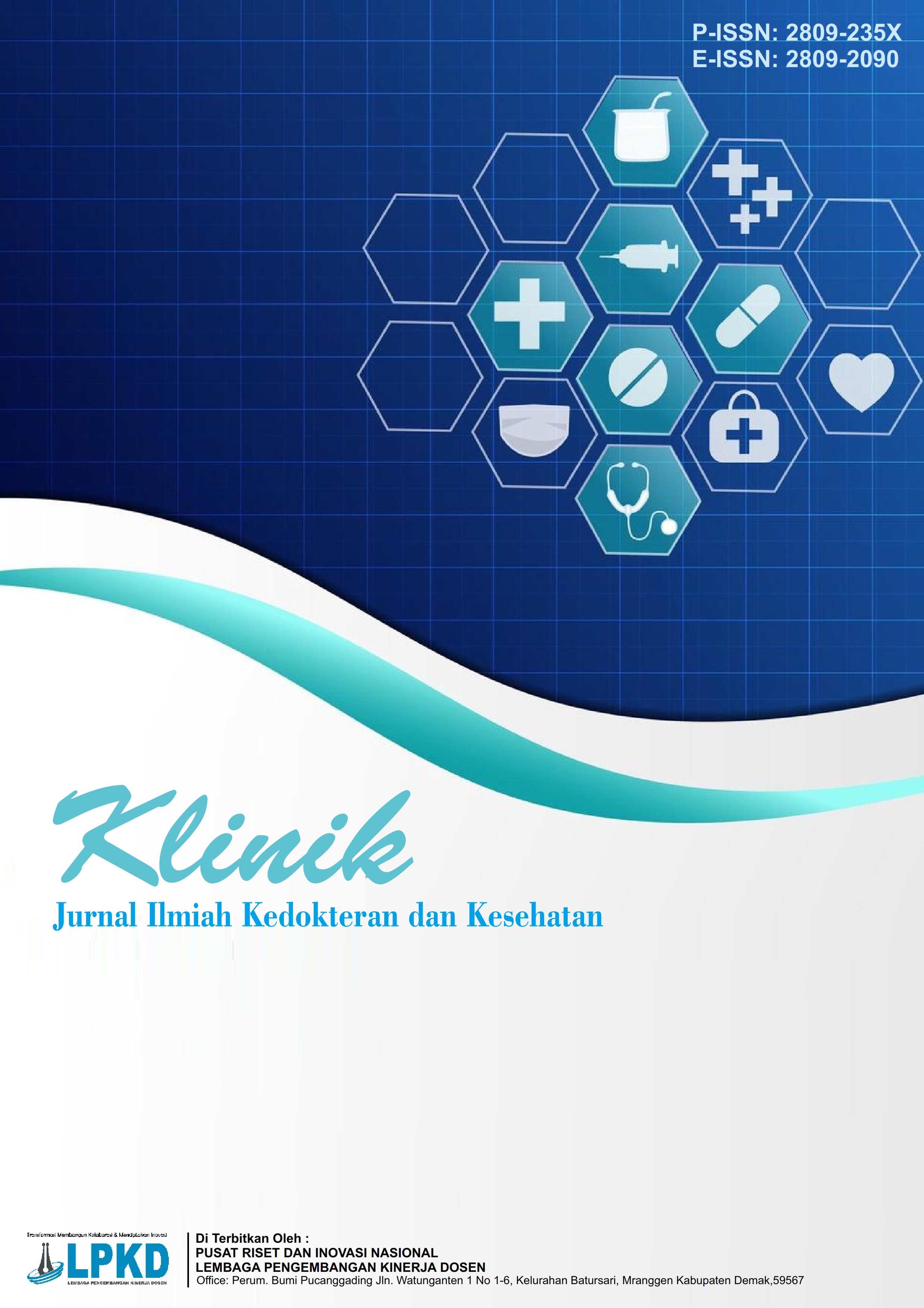Pendekatan dan Pengelolaan Delirium pada Pasien ICU
Deteksi, Intervensi Nonfarmakologi, dan Pencegahan Multikomponen
DOI:
https://doi.org/10.55606/klinik.v5i1.5700Keywords:
ABCDEF Bundle, CAM-ICU, Delirium, ICU, PreventionAbstract
Delirium is an acute neuropsychiatric syndrome characterized by fluctuating disturbances in attention, consciousness, and cognition, frequently observed in critically ill patients in the intensive care unit (ICU). This review aims to summarize current evidence on early detection methods, nonpharmacological interventions, and multicomponent prevention strategies for ICU delirium. The methodology involved a narrative literature review of studies published between 2012 and 2024, focusing on validated screening tools such as the Confusion Assessment Method for the ICU (CAM-ICU) and the Intensive Care Delirium Screening Checklist (ICDSC), their diagnostic performance, and implementation protocols. Findings indicate that daily screening with CAM-ICU (sensitivity ~80%, specificity ~96%) and ICDSC (sensitivity ~74%, specificity ~82%) facilitates timely identification. Nonpharmacological measures, including the ABCDEF bundle—encompassing pain management, spontaneous awakening and breathing trials, choice of sedation, delirium monitoring, early mobilization, and family engagement—have demonstrated efficacy in reducing delirium incidence and duration. Multicomponent prevention protocols such as the Hospital Elder Life Program (HELP) further decrease delirium risk through cognitive orientation, sleep promotion, and sensory support. Implications for practice include adopting standardized screening, embedding bundles into ICU workflows, and prioritizing environmental design modifications. Future research should explore optimized pharmacological adjuncts and cost-effectiveness analyses of bundle implementation.
References
Abelli, M., Pini, S., Martinelli, R., & et al. (2019). Delirium: A reappraisal after DSM-5 transition. Rivista di Psichiatria, 54(5), 212–220.
Boncyk, C., Ely, E. W., & Banerjee, A. (2023). Agitation and delirium. In J. L. Vincent et al. (Eds.), Textbook of Critical Care (8th ed., pp. 45–60). Elsevier.
Chen, T. J., Chung, Y. W., & Chang, H. C. (2021). Diagnostic accuracy of the CAM-ICU and ICDSC in detecting ICU delirium: A bivariate meta-analysis. International Journal of Nursing Studies, 113, Article 103780.
Cirbus, J., MacLullich, A. M. J., Noel, C., & et al. (2019). Delirium etiology subtypes in older emergency department patients. International Psychogeriatrics, 31(2), 235–243.
Davis, D. H. J., Skelly, D. T., Murray, C., & et al. (2015). Worsening cognitive impairment increases risk for delirium. American Journal of Geriatric Psychiatry, 23(4), 403–410.
Kojaie-Bidgoli, A., Sharifi, F., & Maghsoud, F. (2021). The Modified HELP in geriatric hospitalized patients: Randomized controlled trial. BMC Geriatrics, 21(1), 145.
Kotfis, K., van Diem-Zaal, I., & Roberson, S. W. (2022). The future of intensive care: Delirium should no longer be an issue. Critical Care, 26(1), 123.
Landis, J. R., & Koch, G. G. (1977). The measurement of observer agreement for categorical data. Biometrics, 33(1), 159–174.
Moher, D., Liberati, A., Tetzlaff, J., & Altman, D. G. (2009). Preferred reporting items for systematic reviews and meta-analyses: The PRISMA statement. PLoS Medicine, 6(7), e1000097.
Nitchingham, A., Kumar, V., Shenkin, S., & et al. (2018). Neuroimaging in delirium: Predictors, correlates, and consequences. International Journal of Geriatric Psychiatry, 33(5), 791–802.
Oh, E. S., Needham, D. M., & Nikooie, R. (2019). Antipsychotics for preventing delirium: Systematic review. Annals of Internal Medicine, 171(2), 485–495.
Park, S. Y., & Lee, H. B. (2019). Prevention and management of delirium in critically ill adult patients: PADIS 2018 guidelines. Acute and Critical Care, 34(3), 117–135.
Rosa, R. G., Teixeira, C., Piva, S., & Morandi, A. (2024). Anticipating ICU discharge and long-term follow-up. Current Opinion in Critical Care, 30(2), 150–157.
Rosner, B. (2011). Fundamentals of biostatistics (7th ed.). Brooks/Cole.
Saha, S., Noble, H., & Xyrichis, A. (2022). Impact of ICU design on patients, families, and staff: A scoping review. Journal of Critical Care, 67, 101–109.
Schieveld, J. N. M., Van De Riet, E. H. C. W., & Strik, J. J. M. H. (2019). Between healthy and comatose: Neuropsychiatric landscape of critical illness. BMC Psychiatry, 19, 210.
Siddiqi, N., Harrison, J. K., & Clegg, A. (2016). Interventions for preventing delirium in hospitalised non-ICU patients. Cochrane Database of Systematic Reviews, (3), CD005563.
Vincent, J.-L., Slutsky, A. S., & Gattinoni, L. (2017). Intensive care medicine in 2050: The future of ICU treatments. Intensive Care Medicine, 43(12), 2197–2205.
Wilson, J. E., Mart, M. F., & Cunningham, C. (2020). Delirium. Nature Reviews Disease Primers, 6(1), 90.
Xu, W., Wang, H., & Li, J. (2023). Environmental modifications to prevent delirium in the ICU: A systematic review. Journal of Critical Care, 68, 98–105.
Downloads
Published
How to Cite
Issue
Section
License
Copyright (c) 2025 Jurnal Ilmiah Kedokteran dan Kesehatan

This work is licensed under a Creative Commons Attribution-ShareAlike 4.0 International License.








